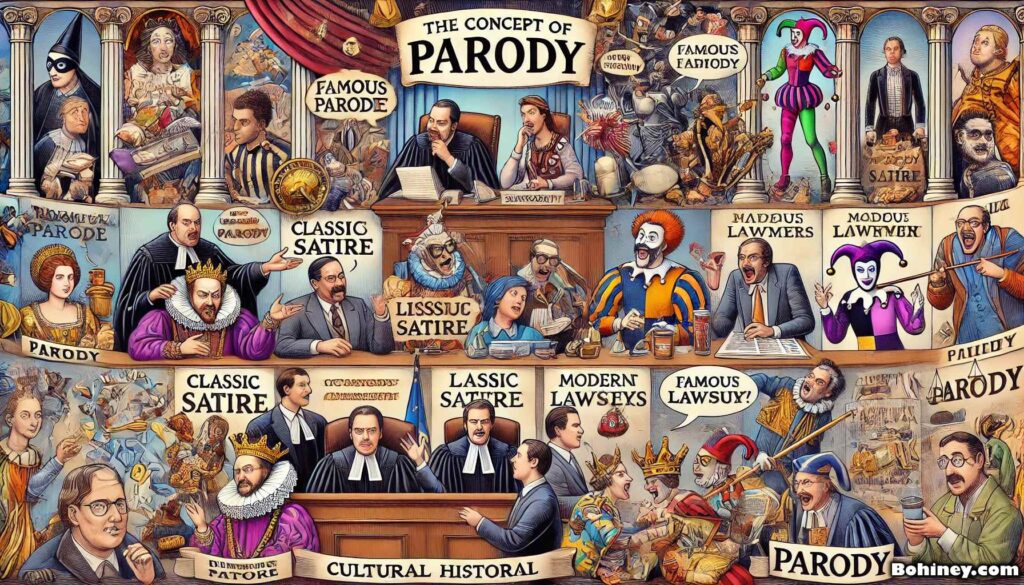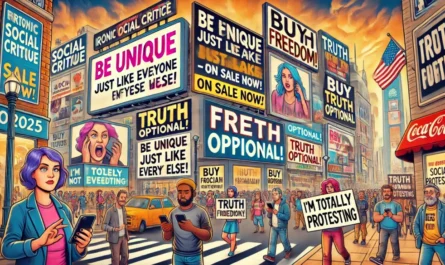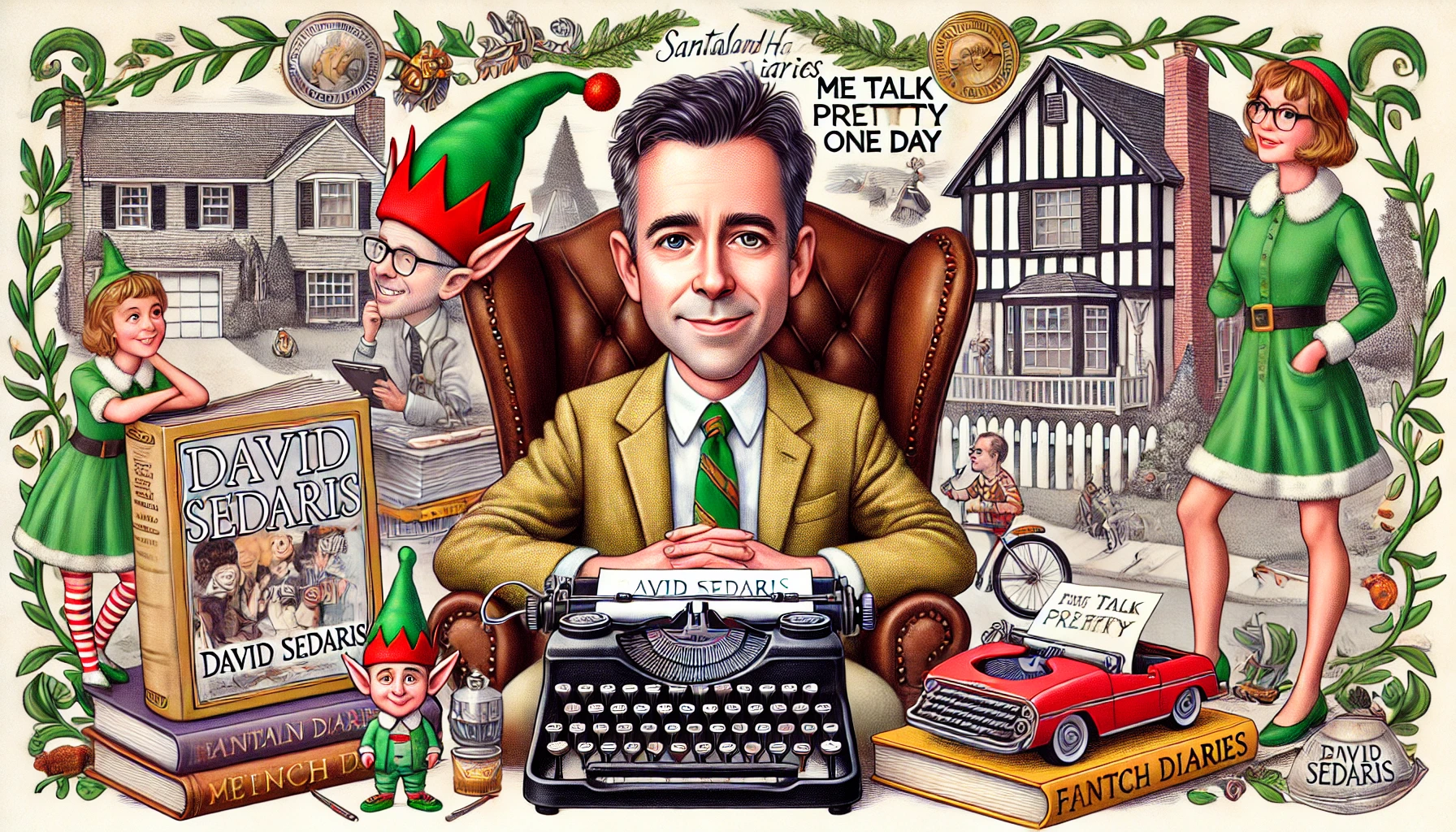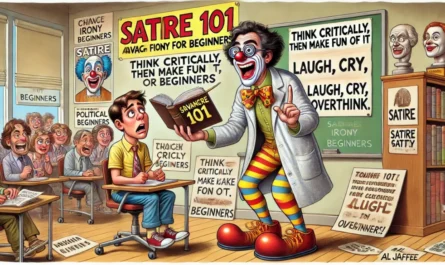Parody:
A
Cultural,
Historical,
and
Legal
Exploration
Parody,
a
creative
form
that
imitates
and
exaggerates
the
style
or
content
of
another
work
for
comedic
or
critical
effect,
has
long
been
a
cornerstone
of
artistic
expression.
Rooted
in
ancient
traditions,
it
serves
as
both
a
mirror
and
a
scalpel,
reflecting
cultural
norms
while
dissecting
them.
This
essay
explores
parody’s
evolution
from
its
classical
origins
to
its
digital-age
manifestations,
examining
its
legal
challenges,
cultural
roles,
and
future
trajectory.
By
analyzing
its
multifaceted
nature,
we
uncover
how
parody
transcends
mere
mockery,
offering
incisive
commentary
and
fostering
societal
dialogue.
Historical
Development
Ancient
Origins
Parody’s
roots
trace
back
to
ancient
Greece,
where
the
term paroidía (meaning
“counter-song”)
emerged.
Aristophanes,
the
comedic
playwright,
masterfully
parodied
tragic
works
in The
Frogs (405
BCE),
where
Dionysus
judges
a
contest
between
Aeschylus
and
Euripides,
lampooning
their
stylistic
excesses.
Similarly,
Roman
writers
like
Horace
and
Juvenal
employed
parody
to
critique
societal
elites,
blending
humor
with
moral
inquiry.
Middle
Ages
and
Renaissance
In
medieval
Europe,
parody
thrived
in
religious
and
secular
contexts.
The Goliards,
wandering
scholars,
penned
Latin
verses
mocking
Church
authority.
Geoffrey
Chaucer’s The
Canterbury
Tales (14th
century)
parodied
chivalric
romances
and
societal
hierarchies,
while
François
Rabelais’s Gargantua
and
Pantagruel (1530s)
satirized
Renaissance
humanism
through
grotesque
humor.
Shakespeare,
too,
woven
parody
into A
Midsummer
Night’s
Dream,
ridiculing
amateur
theater
with
the
play-within-a-play Pyramus
and
Thisbe.
18th–19th
Century
The
Enlightenment
saw
parody
flourish
as
a
tool
of
intellectual
critique.
Alexander
Pope’s The
Rape
of
the
Lock (1712)
mocked
epic
conventions
by
dramatizing
a
trivial
social
quarrel.
Henry
Fielding’s Shamela (1741)
parodied
Samuel
Richardson’s
sentimental
novel Pamela,
exposing
its
moral
hypocrisy.
In
the
19th
century,
Lewis
Carroll’s Alice’s
Adventures
in
Wonderland (1865)
subverted
didactic
children’s
literature,
while
Mark
Twain’s A
Connecticut
Yankee
in
King
Arthur’s
Court (1889)
skewered
romanticized
medievalism.
20th
Century
to
Present
Modernist
and
postmodernist
writers
embraced
parody
to
deconstruct
literary
norms.
James
Joyce’s Ulysses (1922)
parodied
Homer’s Odyssey,
while
Thomas
Pynchon’s The
Crying
of
Lot
49 (1966)
lampooned
conspiracy
theories.
In
film,
Mel
Brooks’s Blazing
Saddles (1974)
and Spaceballs (1987)
ridiculed
Western
and
sci-fi
tropes,
respectively.
Television
shows
like The
Simpsons and Saturday
Night
Live became
cultural
touchstones,
parodying
politics
and
media.
Forms
of
Parody
Literature
Literary
parody
often
targets
genre
conventions.
Miguel
de
Cervantes’s Don
Quixote (1605)
remains
the
quintexample,
mocking
chivalric
romances
through
the
delusional
knight.
Modern
works
like Pride
and
Prejudice
and
Zombies (2009)
mash-up
classic
literature
with
pop
culture,
highlighting
its
enduring
adaptability.
Film
and
Television
Cinematic
parody
ranges
from
slapstick
to
subtle
critique.
Buster
Keaton’s Sherlock
Jr. (1924)
parodied
detective
tropes,
while Airplane! (1980)
spoofed
disaster
films.
TV
parodies
like The
Colbert
Report (2005–2014)
blurred
lines
between
comedy
and
political
commentary,
showcasing
parody’s
subversive
potential.
Music
Musical
parody
often
hinges
on
lyrical
alteration.
“Weird
Al”
Yankovic’s
career
exemplifies
this,
with
hits
like Eat
It (1984),
a
parody
of
Michael
Jackson’s Beat
It.
Hip-hop
artists
like
DJ
Danger
Mouse’s The
Grey
Album (2004)
mash-up
Beatles
and
Jay-Z
tracks,
challenging
copyright
norms.
Digital
Media
The
internet
democratized
parody
through
memes,
YouTube,
and
TikTok. Epic
Movie (2007)
parodies
blockbusters,
while
YouTube
channels
like Bad
Lip
Reading recontextualize
media
with
humorous
dubbing.
Memes,
such
as Distracted
Boyfriend,
critique
societal
obsessions
through
visual
shorthand.
Legal
Landscape
Copyright
and
Fair
Use
U.S.
law
protects
parody
under
fair
use
(Copyright
Act
1976),
requiring
transformative
purpose
and
non-competition
with
the
original.
Landmark
case Campbell
v.
Acuff-Rose
Music (1994)
affirmed
2
Live
Crew’s
parody
of Oh,
Pretty
Woman as
lawful,
stressing
its
social
value.
International
Perspectives
The
EU’s
2014
Copyright
Directive
permits
parody
under
“fair
dealing,”
yet
member
states
vary.
In Deckmyn
v.
Vandersteen (2014),
the
ECJ
ruled
parodies
must
balance
humor
with
rights-holder
interests.
Nations
like
Japan
lack
explicit
parody
exemptions,
stifling
creative
freedom.
Cultural
and
Social
Functions
Critique
and
Commentary
Parody
dismantles
power
structures
by
mocking
authority. Dr.
Strangelove (1964)
critiqued
Cold
War
paranoia,
while The
Daily
Show exposes
media
sensationalism.
By
exaggerating
flaws,
parody
invites
reflection
on
societal
absurdities.
Homage
and
Appreciation
Parody
often
celebrates
its
source,
as
seen
in Galaxy
Quest (1999),
a
loving
spoof
of Star
Trek.
It
bridges
high
and
low
culture,
fostering
intertextual
dialogue.
Community
Building
Shared
understanding
of
parodies
strengthens
cultural
bonds. Monty
Python sketches
became
communal
reference
points,
while
internet
memes
create
global
in-jokes,
uniting
disparate
groups.
Controversies
and
Challenges
Offense
and
Censorship
Parody’s
edge
risks
backlash.
Charlie
Hebdo’s
Muhammad
cartoons
sparked
violent
protests,
raising
questions
about
cultural
sensitivity.
Conversely,
censorship
in
authoritarian
regimes,
like
China’s
bans
on
political
satire,
highlights
parody’s
threat
to
power.
Commercialization
Corporate
co-option
dilutes
parody’s
subversiveness.
Ads
mimicking
viral
memes
or
films
like The
LEGO
Movie (2014),
which
critiques
consumerism
while
promoting
toys,
illustrate
this
tension.
Future
of
Parody
Technological
Innovations
AI
and
deepfakes
enable
hyper-realistic
parodies,
posing
ethical
dilemmas.
Platforms
like
TikTok’s
algorithm-driven
content
may
homogenize
humor,
yet
grassroots
creators
continue
to
innovate.
Globalization
Cross-cultural
parodies,
like
Bollywood
spoofs
of
Hollywood
films,
challenge
Western
dominance.
However,
cultural
nuances
risk
misinterpretation,
necessitating
empathetic
engagement.
Conclusion
Parody,
as
a
dynamic
and
resilient
art
form,
challenges,
entertains,
and
unites.
Its
historical
evolution
and
adaptability
underscore
its
vital
role
in
free
expression.
As
legal
and
digital
landscapes
shift,
safeguarding
parody
ensures
it
remains
a
tool
for
critique
and
connection,
reflecting
humanity’s
enduring
need
to
laugh,
question,
and
reimagine
the
world.

NEWS
—
A
visually
engaging
and
humorous
illustration
representing
the
concept
of
parody
through
cultural,
historical,
and
legal
perspectives.
The
scene
featu…
–
bohiney.com1
Go to Source
Author: Ingrid Gustafsson



